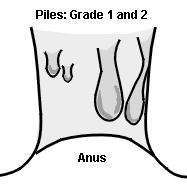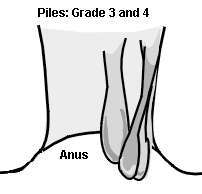PILES (HAEMORRHOIDS)
Definition:
Piles (Haemorrhoids) are swollen and inflamed blood vessels (veins) in the rectum and anus. Piles are broadly classified as follows:
External: Piles that are outside the anal verge
Internal: Piles that occur inside the rectum
Causes of Piles:
These include the following:
- Genetic predisposition (weak rectal veins, walls)
- Poor muscle tone in the rectal region
- Constipation
- Obesity
- Sedentary lifestyle
- Chronic cough
- Pregnancy
- Overuse of laxatives or enemas
- Lifting heavy weights habitually
Symptoms of Piles:
 Symptoms vary depending upon the site of piles, duration of complaints and general health of the person.
Symptoms vary depending upon the site of piles, duration of complaints and general health of the person.
External piles present as a swelling outside the anus with irritation and itching. These can be painful sometimes and usually do not bleed.
Internal piles are usually not painful but these bleed when they are irritated such as during the passage of hard stools. They can be classified into four grades:
- Grade 1 piles are small swellings on the inside lining of the anus. They cannot be seen or felt from outside the anus.
- Grade 2 piles are partly pushed out (prolapse) from the anus when you go to the toilet, but quickly ‘retract back’ inside again.
- Grade 3 piles hang out (prolapse) from the anus and are felt as one or more small, soft lumps that hang from the anus. However, they can be pushed back inside the anus with a finger.
- Grade 4 piles permanently hang down from within the anus, and cannot be pushed back inside. They can sometimes become quite large.
Some of the other symptoms generally associated with piles are:
- Protrusion of piles outside the anus; this usually occurs after defecation, prolonged standing or unusual physical exertion
 Bleeding from the anus: This can occur before, during or after stools. This will be bright red blood, not usually mixed with the stools, but often seen on the toilet paper.
Bleeding from the anus: This can occur before, during or after stools. This will be bright red blood, not usually mixed with the stools, but often seen on the toilet paper.- Soreness, pain, itching in the anal region
- In case of profuse bleeding that is chronic, the patient may be anemic
- The sensation of something coming down, or a bulge or lump at the anus
- If the piles outside the anus develop a blood clot inside, (thrombosed piles) it leads to a particularly tender, hard lump
Homeopathic piles treatment:
Homeopathic medicines are very effective in the management of piles and the symptoms associated with it such as pain, bleeding, itching, etc. The point to be emphasized is that the relief of symptoms is obtained with absolute gentleness and without invasion or surgery of any kind. Moreover, the condition has a high relapse rate following surgical treatment, since surgery does not target the root causes like genetic tendencies, habitual constipation, etc. Homeopathic medicines work at the root level and can modify these genetic tendencies thus reducing chances of relapse and recurrence of the condition significantly. Grade 1 and 2 of internal piles treatment can be significantly helped with homeopathy. Grade 3 piles can find some relief of symptoms with homeopathy but may not be completely cured. Grade 4 piles can get symptomatic relief with medicines.
Tips on how to prevent piles
Piles if not controlled in time can create problems in the long run, follow the tips below for preventing piles.
- Increase intake of fluids (Juices & Water)
- High fiber diet
- Exercise regularly
- Sit in warm water tub for minimum 10 minutes
- Eat more fresh fruits and vegetables
- Avoid processed foods
- Control your weight
- Avoid too much alcohol
- Quit smoking
